Professional Fujifilm XT1 lenses for every taste and budget.
A high-quality lens can be instrumental in significantly improving the look of your photos, as long as you pick the correct one in each situation. Each lens type is designed for different kinds of images so knowing the difference between them is crucial. In the post below, you’ll find an overview of the best lenses for Fuji XT1 that will help you easily determine which model suits your needs the most.
Look at the best lenses for Fuji XT1 that the market has to offer. Read about their pros and cons, technical specifications, think about your needs and choose the lens that fits your taste perfectly.
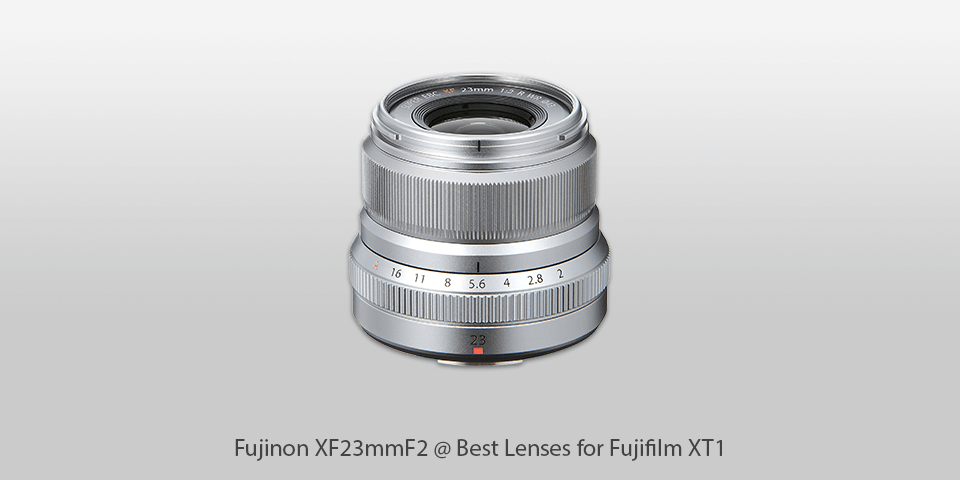
Mount: X | Diaphragm blades: 9 | Autofocus: yes | Min focus distance: 22cm | Max magnification: 0,13x | Filter thread: 43mm | Dimensions (WxL): 60 x 51.9 mm| Weight: 180 g
⊕ Terrific compact design
⊕ High-quality optics
⊕ Almost non-existent distortion
⊕ Even illumination
⊖ Lacks optical stabilization
⊖ Doesn’t have a focus clutch
The design quality of the Fujinon XF23mm F2 allows it to earn its place among the best lenses for Fuji XT1. The lens is small, offers sharp optics, and comes with sealing from dust and water. However, it doesn’t provide the same depth of field adjustments or light transmission as its bigger sibling – the XF 23mm F.14, and manual focusing feels clunky as well. That said, if you account for the fact that this model costs half as much while still producing a high-quality image with a nice backdrop blur, there’s not much to complain about.
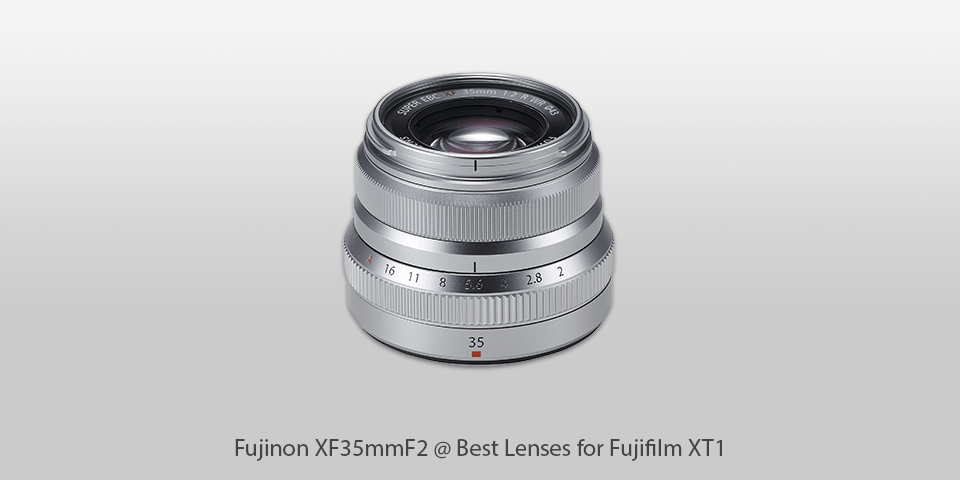
Mount: X | Diaphragm blades: 9 | Autofocus: yes | Min focus distance: 0.3m | Max magnification: 0,2x | Filter thread: 35mm | Dimensions (WxL): 4.1 x 6.3 x 3.8 inches| Weight: 170 g
⊕ Small
⊕ Terrific optics
⊕ Weather sealing
⊕ Aperture ring
⊖ Lacks optical stabilization
⊖ Can’t change filters without removing the hood
If you’re looking for budget-friendly Fuji XT1 portrait lenses, then the XF35mm F2 definitely deserves your attention. Available for as low as $400, it’s a solid pick for any photographer that has a Fujifilm mirrorless camera. The lens is small, weather-resistant, and capable of producing satisfyingly sharp images. It does suffer from a couple of drawbacks, namely, the lack of optical stabilization (which is missing in many standard primes), and the minor muddiness of the edges at wider apertures. That said, the strengths of the lens far outweigh the weaknesses, making it a solid option for any XT1 camera owner.
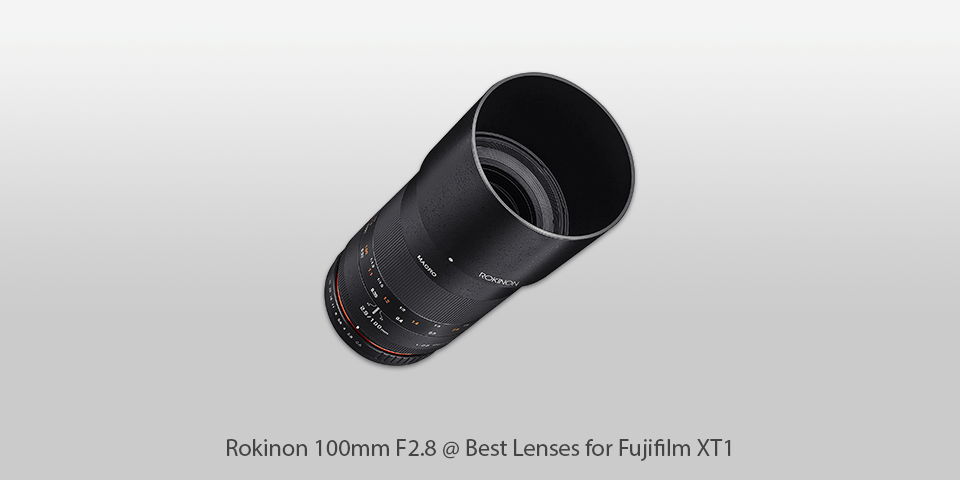
Mount: X | Diaphragm blades: 9 | Autofocus: yes | Min focus distance: 30.7 cm | Max magnification: 1x | Filter thread: 67mm | Dimensions (WxL): 72.5 x 149.4 mm| Weight: 770 g
⊕ Nice sharpness when stopped down
⊕ 1:1 magnification
⊕ Built-in focus design
⊕ Small size
⊖ Minor edge softness at wider apertures
⊖ Manual focusing might be off-putting
⊖ Doesn’t have optical stabilization
Despite being regarded as one of the best lenses for FujiXT1, the Rokinon 100mm F2.8 still has its setbacks. The most notable of them is the edge softness that appears at wide apertures. The lens produces a highly sharp image on most of the frame, even at f/2.8. Moreover, the edges offer nice sharpness as well as long you’re taking photos at narrower apertures, which you can use for zooming. Regardless if it’s marketed as Rokinon or Samyang, this product offers solid performance down to f/16. The manual focusing system might feel unintuitive for some photographers, but if you’re using a tripod and Live View for framing the shots, you can focus on the subject with high precision.
If you’d like to find a lens that has a metal body and a larger max aperture, you can check out the Zeiss Makro-Planar T2/100, but it’s significantly more expensive and offers only half of Rokinon’s max magnification power. If you’re not limited in funds, consider investing a little more and getting a macro prime lens with AF and VR systems, like the ones included in the Micro-Nikkor 105mm, which costs a lot, but more than makes up for it with its quality.
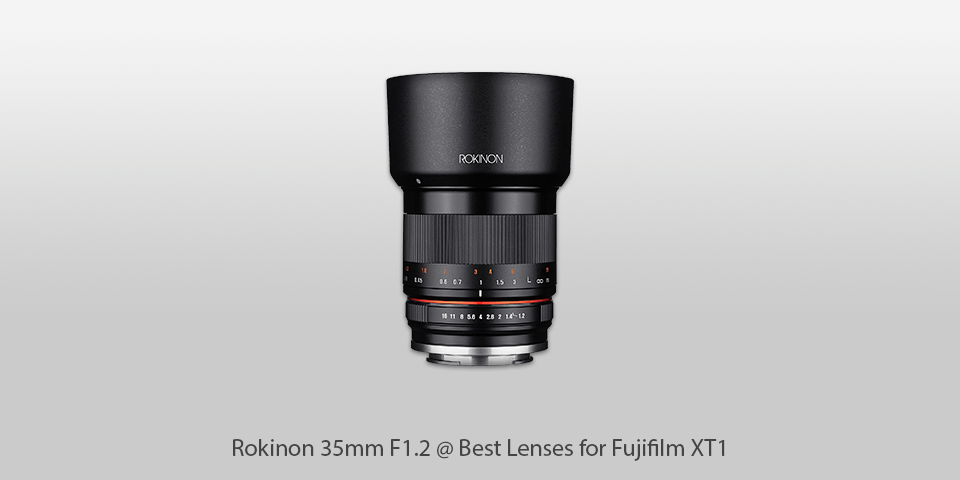
Mount: X | Diaphragm blades: 9 | Autofocus: yes | Min focus distance: 0,38m | Max magnification: 0,2x | Filter thread: 62mm | Dimensions (WxL): 2.92 x 2.92 x 2.67 inches| Weight: 14.9 ounces
⊕ Built-in focus
⊕ Min chromatic aberrations
⊕ Circular aperture
⊕ Low Coma
⊖ Rather expensive
This Fuji XT1 35mm lens was developed for APS-C cameras and offers terrific speed. You can use it with Sony’s E-mount, Micro Four Thirds, FujiX, and Canon M mount systems. Its max aperture of f/1.2 provides high brightness, enables you to adjust the depth of field as you see fit, while also being perfectly suited for taking photos in low-light conditions. Build-wise, the lens comes with a single extra-low dispersion component and a pair of aspherical components that all serve to reduce chromatic and spherical aberrations, allowing you to enjoy clear, sharp images.
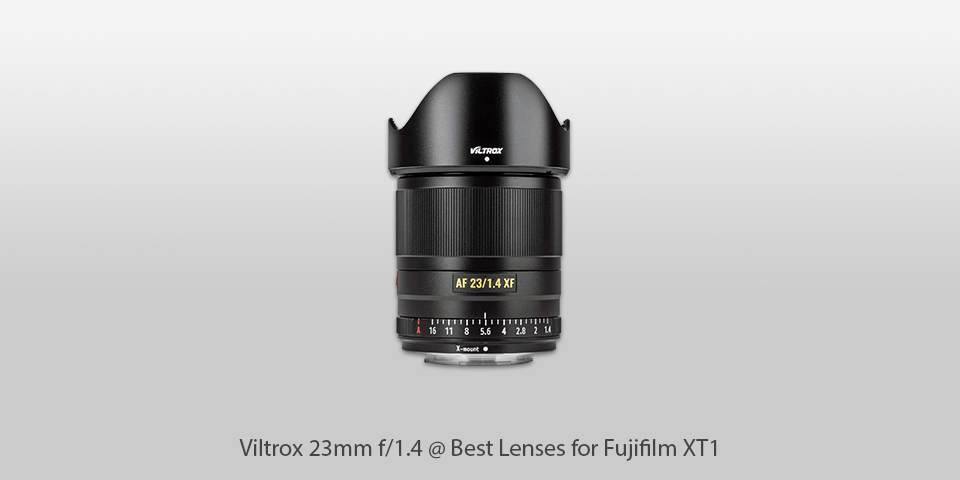
Mount: X | Diaphragm blades: 9 | Autofocus: yes | Min focus distance: 0.3m | Max magnification: 0,2x | Filter thread: 52mm | Dimensions (WxL): 65x72mm | Weight: 260g
⊕ Aperture rings
⊕ Small and light
⊕ Impressive autofocus
⊕ Fast and quiet video AF
⊖ f/1.4 can suffer from glow
⊖ Bokeh might be too strong at times
⊖ Doesn’t feel sturdy because of design
This Viltrox product deserves to be among the best lenses for Fuji XT1 as it offers a focal length equivalent to 35mm on full-frame sensors. It has an aperture range of F1.4-16, employs a 9-blade diaphragm, sports a minimal focus distance of 30 centimeters (about 15 inches), and relies on HD Nano multi-layer coating to resist water and reduce chromatic aberrations.
The lens comes in a sturdy, metal body that improves precision and offers superior durability. Thanks to its compact build and a weight of a mere 260g, the Viltrox 23mm f/1.4 is pleasantly portable and comfortable to hold and use. The built-in STM motor ensures silent, fast, and accurate AF performance, while the manual focus mode allows you to take full control when it’s needed. Moreover, the built-in focusing mechanism ensures the lens’ length remains unchanged, allowing you to enjoy better handling and faster response.
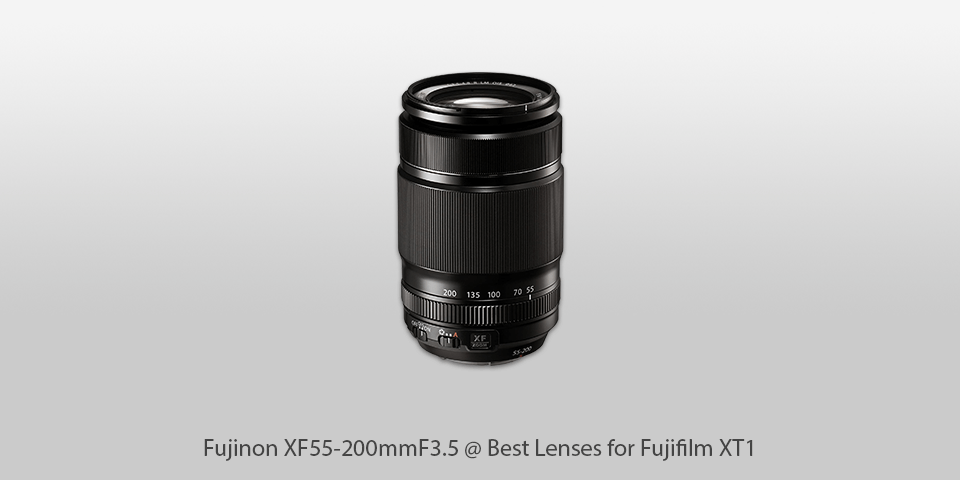
Mount: X | Diaphragm blades: 7 | Autofocus: yes | Min focus distance: 1.1m | Max magnification: 0.18x | Filter thread: 62mm | Dimensions (WxL): 75 x 118 mm| Weight: 580 g
⊕ Full-frame sharpness even at wide open
⊕ Larger aperture compared to the competition
⊕ Optical stabilization
⊖ High price
⊖ Doesn’t offer weather-sealing
The XF55-200mm F3.5 is a lens for Fujifilm XT1 that feels like it belongs attached to a professional-grade camera. It offers an f/3.5-4.8 aperture that gathers noticeably more light compared to similar lenses such as Samsung’s 50-200mm F4-5.6 ED OIS III NX. That said, it also has a bigger price tag, meaning that if you want to enjoy superior quality, you’ll have to pay for it.
The best features of this lens include high sharpness across the entire frame, virtually non-existent distortion, and an efficient stabilization system. If you want to up the ante even more, you can consider getting the XF50-140mm F2.8 R OIS WR. On the other hand, if you’re ready to make do with slightly worse a build quality and light transmission, then you can check out the XC50-230mm F4.5-6.7 OIS as a budget-friendly telezoom model.

Mount: X | Diaphragm blades: 9 | Autofocus: yes | Min focus distance: 35cm | Max magnification: 0,25x | Filter thread: 72mm | Dimensions (WxL): 78.3 x 88.9 mm| Weight: 440 g
⊕ Built to withstand extreme weather
⊕ Impressive optical performance
⊕ Aperture control ring
⊕ 1:4 macro focusing
⊖ Front element lacks anti-smudge coatings
⊖ Edge quality drops at f/4
Out of all the best lenses for Fuji XT1 in its lineup, the Fujinon XF16-80mm F4 is the most interesting option. It offers reliable weather sealing, optical stabilization, and a terrific combination of the zoom range, max aperture, and optics quality.
You can get it either separately for the full price or at a discount as a kit lens for the X-T3 and X-T4 cameras if you decide it’s time to upgrade from the XT1. If you’re a professional who can survive without optical stabilization, you can also check out the XF 16-55mm F2.8 option as its brighter aperture and more reliable weather resistance properties make it a preferable choice for event and outdoor photography.
The Fujinon XF16-80mm F4 offers a larger zoom range compared to most beginner-grade lenses, while still being priced as one and included in several affordable camera kits.
| Image | Name | Features | |
|---|---|---|---|
 |
Fujinon XF23mmF2
Our choice |
CHECK PRICE → | |
 |
Fujinon XF35mmF2
Affordable |
CHECK PRICE → | |
 |
Rokinon 100mm F2.8
Telephoto |
CHECK PRICE → |

Purchasing a lens for Fujifilm XT1 can seem like a tremendous undertaking once you see the number of high-quality choices you have to choose from. That’s why making sense of each lens type can do wonders for simplifying the selection process.
Each model comes with features that make it perfectly suited for specific photoshoots. Some lenses are designed for wedding photography, while others are created to capture dynamic moments during sports games.
Establishing the differences between the most popular types of XT1 lenses will help you determine which type is best suited for your needs. If you mainly organize portrait photoshoots, you’ll need a different lens than a landscape photographer.
Check out this brief overview of the different types of lenses that are available for a Fuji XT1 camera:
Prime lenses: This type is considered the standard one and it’s well-suited for all sorts of photography genres. However, while such lenses offer good performance across the board, professionals mainly use primes for portraiture and wedding photography.
Wide-angle lenses: This type is great for increasing the exposure of a photo and providing even sharpness across the entire frame. Such lenses are the perfect fit for outdoor photography, particularly for taking pictures of landscapes, wildlife, and birds.
Macro lenses: This type was created to take extra close-up photos of interesting subjects. Such lenses are a nice fit for nature, product, and still life photography.
While these 3 types are the most popular ones, the market also offers other kinds of lenses. Some models come with ultra-wide-angle support, giving you an even larger field of view, while fisheye lenses are often used by sports and landscape photographers.
When choosing between the best lenses for Fuji XT1, you have to consider several aspects. All lenses are different, as you have to pick between multiple brands and each brand makes sure all of its products are unique and are suited for different photography genres.
Begin by establishing your budget. Some lenses come with a high price tag, while other models are much more reasonably-priced. Figure out how much you can afford to invest in a lens and only look at products that fall into your budget range.
Next, think about what type of photos you’ll usually take. If you plan to take up wedding or event photography, then a prime lens should probably be your first choice. If, on the other hand, you’re more interested in nature and landscapes, then give preference to wide-angle models instead.
Other aspects that deserve your attention include:
Autofocus system: AF can be a lifesaver when taking photos. Try to find a lens that has integrated autofocus. Be sure that the product also allows you to switch to manual focusing when needed
Weight: The weight of a lens is important because it can make your camera substantially heavier than it already is. If it’s too bulky, it can make the process of holding and using the camera for prolonged periods exhausting and irritating.
Package contents: Some models are shipped with a storage case, which can come in handy when you want to store or transport the lens without risking damaging it.
Weather resistance: Many lenses come with special coatings that resist splashes, dust, and smudges. Such properties can do wonders for ensuring the lens serves you for years to come.

When picking between the best lenses for Fuji XT1, you’ll stumble upon several terms and abbreviations that might confuse you. Be sure to read about each term to have a clear understanding of what the letters stand for. Only then can you be certain that you know what you’re purchasing.
XF / XC – Stands for the lens series to which a specific model belongs to.
LM – Stands for the inclusion of a linear motor that serves to enhance the AF system speed.
WR – Stands for weather-resistant properties (like a hood), which are integrated into the lens.
OIS – Stands for integrated Optical Image Stabilization, which is crucial for filming videos and dealing with camera shake. The focal length is described in millimeters. For instance, a fixed lens can be 50mm, while versatile models offer a focal length range like 18-35mm.
The aperture of a lens is described with an “F” before the number - for instance – F/2.5. In some situations, the aperture is presented in a range, meaning you can adjust it to accommodate specific shooting conditions. For instance, some lenses have an F/2.5-3.6 aperture range.
Since Fujifilm has nearly established a monopoly on X-mount optics, they can afford to set any price they want. Since the only other options out there are cheap manual ones and even more costly Zeiss products, most photographers have no choice but to purchase Fujifilm lenses. Thankfully, now that Viltrox has entered the market, that situation can change in the following years.
Yes, there is a plethora of XT1 lenses that provide the level of quality necessary to take professional photos. The best options offer a compact design, weather sealing, and a lightweight build. The only major drawback that some models suffer from is the lack of optical stabilization.
There’s a solid selection of Nikon lenses that can be easily attached to a Fuji camera and provide smooth performance.
"R" stands for Ring, meaning a specific lens comes with a handy aperture ring.

 Rating
Rating